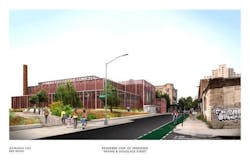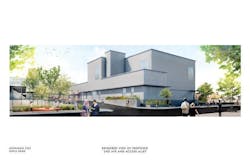New York City breaks ground on storage tanks for CSOs
New York City has broken ground on the first of two underground storage tanks to increase the capacity of the city’s combined sewer system, reducing the potential for combined sewer overflows.
“Today’s groundbreaking will protect the Gowanus Canal from pollution and deliver acres of new public spaces and waterfront access to New Yorkers,” said New York City Mayor Eric Adams. “This project is a powerful statement about our city’s adaptability and determination, and we’re not stopping here in Gowanus. We want to make sure that every waterway in New York City is clean enough for the dolphins we saw in the Bronx River to swim in, and whenever we have opportunities to bring new public open spaces to communities that are crying out for them, we’re going to seize those chances.”
The two tanks will have a combined capacity to retain up to 12 million gallons of sewer overflow during rainstorms. The two major infrastructure projects will make an estimated $1.6 billion investment in Brooklyn’s waterways and public spaces, significantly improve the health of the canal, and create 3.6 acres of new public waterfront open space and amenities for the Gowanus community.
The groundbreaking marks an important alignment among city leadership and the EPA to get these projects on track after Gowanus was categorized as a Superfund site in 2010.
“People in Gowanus have been waiting for this day for a long time, and, today, we’re proud to say that the wait is over,” said Deputy Mayor for Operations Meera Joshi. “We’re breaking ground on 3.6 acres of new public space and two tanks that will protect the Gowanus Canal, ultimately delivering a cleaner community with a better quality of life for residents. And we’re grateful to have true partners in this effort at all levels — from the EPA, to local, state, and federal elected officials to community advocates, all dedicated to making Gowanus a better place to live.”
The Gowanus Canal was originally a tidal creek winding through marshland, but, in the 1860s, it was converted into a 100-foot-wide, 1.8-mile-long canal for industrial use. Chemical plants, oil refineries, and other heavy industries operated next to the canal and discharged their waste into it. Sewer overflows only added to this pollution. The EPA declared the location a Superfund site in 2010 and kicked off efforts to clean the canal and remediate the area.
By intercepting the overflow from the sewer system during rainstorms, the underground tanks — announced as part of today’s groundbreaking — will help keep the remediated canal clean. In addition to the sewage overflow tanks at the center of the announcement, as a part of the Superfund designation, EPA is in the process of dredging approximately 581,000 cubic yards of polluted sediment from the bottom of the canal and capping the bottom to prevent further contamination.
Breaking Ground on First Tank
Over the last year, the city has cleared the project site, including carefully deconstructing and salvaging the brick, terracotta, and bluestone elements of the 1913 Gowanus Station building, which will be reconstructed as a part of the project.
In addition to the tank, the project will include a headhouse building to host the mechanical and electrical systems for the tank, odor control equipment, and screens that will remove debris from the sewer overflow.
Atop the tank, which extends underground nearly two blocks from Butler Street to Degraw Street, the city will construct a 1.6-acre waterfront public open space. The landscape will feature a waterfront esplanade with reclaimed concrete block benches, large planted areas that frame views to the canal, gently sloped lawns bordered with seatwalls and benches, granite pavers, and weathered steel accents. Areas of plantings will manage stormwater runoff and reduce the heat island effect.
Plans for the Second Tank
Similar to the other site, this project will include a headhouse to support the tank and two acres of waterfront public open space. The city has already begun bulkhead replacement work on site, and, over the last year, staff have conducted a robust community engagement process to inform the design of the city’s facilities and public open space.
The two-acre public open space wraps the full 1,770 linear feet of waterfront of the site. The design includes a 3,000-square-foot tidal wetland on the southwestern tip of the peninsula, water access at the Second Avenue street end, and New York City’s first-ever public ADA-accessible kayak launch at the Sixth Street turning basin.




